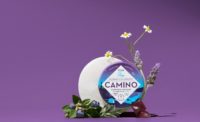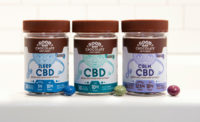Carrie Solomon, co-founder of Leif Goods, Portland, OR, understands why chocolate is an ideal carrier for cannabinoids such as tetrahydrocannabinol (THC) and cannabidiol (CBD).
Lipophilic cannabis oils combine harmoniously with cocoa butter, the fat extracted from cocoa beans that gives chocolate its smooth texture. Cocoa also offers its own health benefits, thanks to the presence of flavanols, which support cardiovascular and cognitive health.
Those aren’t the only reasons, however.
“You never forget to take your chocolate,” Solomon says. “You may forget to take a vitamin, but you’re going to crave that chocolate. It’s a very delicious way to take a moment to stop and enjoy something while choosing an alternative wellness method.”
Cannabis consumers seem to agree. BDS Analytics reported chocolate bars are among the top 10 cannabis product categories, generating $33 million in sales in California, Colorado and Oregon between January and May 2019.
Furthermore, in a 2019 survey conducted by EcoFocus Worldwide, 40 percent of edibles consumers had tried chocolate bars. Additionally, two-thirds of survey respondents cited chocolate as their top edible flavor, followed by fruity (44 percent) and tropical (32 percent).
While their chemical components make chocolate and cannabinoids compatible, producers of cannabis-infused chocolate also say the medium allows for elevating the cannabis consumption experience and serves as an access point for discerning cannabis consumers.
“We always knew we had the type of consumer that was food and flavor first,” Solomon says. They weren’t looking for a highly psychoactive experience. “They wanted something more balanced and manageable.”
Ingredient Details
Chocolatiers, pastry chefs and product developers who work with chocolate quickly learn not all chocolate is created equal.
Dark chocolate typically contains at least 60 percent cocoa, meaning it is more bitter and less smooth in texture. Milk chocolate, which contains between 30 and 60 percent cocoa, contains more sugar and dairy, giving it a smoother texture. White chocolate has no cocoa solids. It contains at least 20 percent cocoa butter, sugar and dairy, making it sweeter and easy to melt.
Product manufacturers can purchase premade industrial chocolate or couverture, chocolate made with extra cocoa butter for a glossy appearance, from ingredient suppliers. They can also take on the challenge of making chocolate from imported cocoa beans.
GATAKA, a CBD-infused bean-to-bar chocolate brand based in Thornton, CO, crafts chocolate from Camino Verde cacao sourced in Ecuador. Roasting, winnowing and grinding its own beans gives GATAKA total control of the production process, especially when it comes to incorporating cannabinoids, says Gila Dar, co-founder. “Anyone can buy a block of chocolate, melt it down and add the CBD. It can get tricky, though, in terms of getting the right dosing. Because we have control of the whole process, and because we’re making it from scratch, we have full control of the dosing and how well it’s integrated into the batch of chocolate.”
Sourcing cannabinoids from reputable, transparent suppliers is essential, but cannabis-infused chocolate manufacturers should also consider how cannabinoids will impact their end product’s flavor.
Marji Chimes, chief marketing officer, Coda Signature, Denver, says the company uses cannabis oil extracted with carbon dioxide in its chocolate bars and truffles, which provides a more-pronounced cannabis flavor than the distillates it uses in its pâte de fruit confections. “Our chocolate doesn’t cover up the cannabis flavor, but it doesn’t come across as ‘hashy,’” she says.
GATAKA is transitioning to a vapor-extracted, full-spectrum CBD oil that features nutty notes, which Dar believes will complement the Ecuadorian cacao. “It’s a combination of quality and flavor for us,” she says. “CBD can have good quality, but it doesn’t taste the best. We want our chocolate to be delicious and indulgent.”
Once their formulas are perfected, manufacturers must melt chocolate to deposit it into moulds for tablet bars, truffles and bonbons. But before reaching that stage, chocolate must be tempered—not an easy feat for even the most-experienced chocolate handlers.
“Chocolate is very temperamental,” Chimes says. “There are days when the chocolate doesn’t want to temper the way it’s supposed to, and that has to do with the weather, it has to do with the time of year. Tempering is a challenge—not just with cannabis, but working with chocolate in general.”
Tempered chocolate has been precisely heated and cooled so small, consistent cocoa butter crystals form. Tempering delays fat bloom—unattractive (but safe) white patches that appear on the surface of chocolate—and give the finished product shine and a snappy texture.
Even if cannabis-infused chocolate products are crafted with care, they still must undergo in-house and third-party testing to ensure cannabinoid levels match what will be listed on packaging. Making those test results available to customers is important, Solomon says. “Those people who have transparency are going to be the ones to win the day, because consumers are going to wise up and really need this information to make the purchase.”
Flavor and Format
Quality appears to reign across the cannabis-infused chocolate space, from the base chocolate to flavor inclusions, Solomon notes. “We’ve got people doing straight milk or dark chocolate, we have other people putting in interesting stuff like we do,” she says. “Overall, we know consumers don’t necessarily want to have to choke down something that tastes unpleasant. I’m glad people are working harder to provide something that tastes yummy even if it’s super potent.”
Leif Goods offers a Mint Hibiscus bar made with 66 percent organic, fair trade dark chocolate, Oregon peppermint oil and a 1:1 ratio of THC and CBD. It’s also dusted with pulverized hibiscus flower. Meanwhile, the company’s Peanut Butter and Jelly bar is made with 66 percent organic, fair trade dark chocolate, peanut butter and 1:1 ratio of THC and CBD. It’s dusted with strawberry powder.
Leif Goods also offers a Salted Chocolate Bar made with 66 percent organic, fair trade dark chocolate and Black Diamond Flake Sea Salt. It has a 20:1 ratio of CBD and THC, with 100 mg of CBD and 5 mg of THC. The company was looking to offer a more-balanced product for people who were looking for a higher ratio of CBD and great flavor, notes Solomon. “It was important for us to be able to present it that way.”
Chimes notes that Lauren Gockley, director of edibles at Coda Signature, seeks to offer an all-encompassing experience, offering chocolate bars in flavors designed to evoke nostalgic feelings. Gockley honed her craft working in a series of pastry shops in Paris, and then worked under great chefs like Jean-Georges Vongerichten and Thomas Keller in the U.S.
Coda Signature’s Coffee & Doughnuts bar is available in Colorado’s recreational market in three forms: 100 mg of THC or 100 mg of THC and 100 mg of CBD for recreational consumers, and 300 mg of THC for medical consumers. It combines milk chocolate, coffee, toasted milk and a dusting of cinnamon sugar. The Maple & Pecan bar, available with 100 mg of THC, features sweet maple, smooth pecan butter, wood-smoked sea salt and darkened milk chocolate. Coda Signature products provide a full sensory experience, from the packaging, to the smell and taste of the product, notes Chimes. “It’s also an emotional connection.”
Chimes also points to Coda Signature’s truffle collections, which feature 10 mg of THC in each piece. Before pouring and filling the chocolate shells, they’re hand-painted with cocoa butter for a sophisticated look and feel. “They’ve been very popular, but it’s expensive to make them that way,” she says. “We’re looking at how to maintain the hand craftsmanship, but also be able to do it faster and more efficiently.”
GATAKA offers chocolate peanut butter and almond butter cups with 20 mg of CBD per piece, making it easy for consumers to monitor their cannabinoid intake.
No matter the format, delivering cannabinoids with high-quality chocolate and other thoughtful ingredients is sure to capture the attention of cannabis consumers.
“THC and CBD are amazing compounds,” says Solomon, “and we want to celebrate those things with the best-quality ingredients we can possibly find.”









